Milkweed Fiber Nonwovens for Sustainable Thermal and Acoustic Building Insulation
Abstract
1. Introduction
2. Materials and Methods
2.1. Material
2.2. Sample Preparation
2.3. Physical Properties
2.3.1. Thickness
2.3.2. Bulk Density
2.4. Thermal Characterization of Samples
2.5. Acoustic Characteristics Measurement
2.5.1. Non-Acoustical Parameters
2.5.2. Measurements of the Sound Absorption Coefficient
Johnson–Champoux–Allard Model
3. Results
3.1. Properties of the Nonwovens
3.2. Thermal Insulation
3.2.1. Thermal Conductivity
3.2.2. Thermal Resistance
3.3. Acoustic Properties
3.3.1. Analysis of Sound Absorption Coefficient with Impedance Tube
3.3.2. Analysis of Sound Absorption Coefficient Using the JCA Model
3.3.3. Classification of Absorbing Materials According to ISO 11654
4. Conclusions
Author Contributions
Funding
Institutional Review Board Statement
Informed Consent Statement
Data Availability Statement
Acknowledgments
Conflicts of Interest
References
- IEA. GlobalABC Roadmap for Buildings and Construction 2020–2050. Towards a Zero-Emission, Efficient, and Resilient Buildingsand Construction Sector. 2020. Available online: https://iea.blob.core.windows.net/assets/6cca78af-2327-4e97-868c-294d48cb66b3/GlobalABC_Roadmap_for_Buildings_and_Construction_2020-2050.pdf (accessed on 15 May 2025).
- Government of Canada. Stratégie Canadienne de Développement à Faible Emission de Gaz à Effet de Serre à Long Terme Pour le Milieu du Siècle. Available online: https://publications.gc.ca/collections/collection_2017/eccc/En4-291-2016-fra.pdf (accessed on 15 May 2025).
- Hung Anh, L.D.; Pásztory, Z. An overview of factors influencing thermal conductivity of building insulation materials. J. Build. Eng. 2021, 44, 102604. [Google Scholar] [CrossRef]
- Schiavoni, S.; D’Alessandro, F.; Bianchi, F.; Asdrubali, F. Insulation materials for the building sector: A review and comparative analysis. Renew. Sustain. Energy Rev. 2016, 62, 988–1011. [Google Scholar] [CrossRef]
- Holbery, J.; Houston, D. Natural-fiber-reinforced polymer composites in automotive applications. JOM 2006, 58, 80–86. [Google Scholar] [CrossRef]
- Ahmad, F.; Choi, H.S.; Park, M.K. A Review: Natural Fiber Composites Selection in View of Mechanical, Light Weight, andEconomic Properties. Macromol. Mater. Eng. 2015, 300, 10–24. [Google Scholar] [CrossRef]
- Agarwal, J.; Sahoo, S.; Mohanty, S.; Nayak, S.K. Progress of novel techniques for lightweight automobile applications throughinnovative eco-friendly composite materials: A review. J. Thermoplast. Compos. Mater. 2020, 33, 978–1013. [Google Scholar] [CrossRef]
- Khan, F.; Hossain, N.; Mim, J.J.; Rahman, S.M.; Iqbal, M.J.; Billah, M.; Chowdhury, M.A. Advances of composite materials inautomobile applications—A review. J. Eng. Res. 2024, 13, 1001–1023. [Google Scholar] [CrossRef]
- Ali, A.; Shaker, K.; Nawab, Y.; Jabbar, M.; Hussain, T.; Militky, J.; Baheti, V. Hydrophobic treatment of natural fibers and their composites—A review. J. Ind. Text. 2018, 47, 2153–2183. [Google Scholar] [CrossRef]
- Pan, Z.; Tuladhar, R.; Yin, S.; Shi, F.; Dang, F. Feasibility of Repairing Concrete with Ultra-High Molecular Weight Polyethylene Fiber Cloth: A Comprehensive Literature Review. Buildings 2024, 14, 1631. [Google Scholar] [CrossRef]
- Rodríguez Neira, K.; Cárdenas-Ramírez, J.P.; Rojas-Herrera, C.J.; Haurie, L.; Lacasta, A.M.; Torres Ramo, J.; Sánchez-Ostiz, A. Assessment of Elaboration and Performance of Rice Husk-Based Thermal Insulation Material for Building Applications. Buildings 2024, 14, 1720. [Google Scholar] [CrossRef]
- Korjenic, A.; Petránek, V.; Zach, J.; Hroudová, J. Development and performance evaluation of natural thermal insulation materials composed of renewable resources. Energy Build. 2011, 43, 2518–2523. [Google Scholar] [CrossRef]
- Prabhakaran, S.; Krishnaraj, V.; Kumar, M.S.; Zitoune, R. Sound and Vibration Damping Properties of Flax Fiber Reinforced Composites. Procedia Eng. 2014, 97, 573–581. [Google Scholar] [CrossRef]
- Xiang, H.-F.; Wang, D.; Liua, H.-C.; Zhao, N.; Xu, J. Investigation on sound absorption properties of kapok fibers. Chin. J. Polym. Sci. 2013, 31, 521–529. [Google Scholar] [CrossRef]
- Hosseini, M.; Gaff, M.; Wei, Y.; Tu, C. Engineered Bamboo Building Materials: Types, Production, and Applications. Forests 2025, 4, 662. [Google Scholar] [CrossRef]
- Kindangen, J.I.; Rogi, O.H.A.; Gosal, P.H. Thermal Performance Evaluation of Buildings with Coconut Leaf Roofs. Civ. Eng. Archit. 2025, 13, 965–975. [Google Scholar] [CrossRef]
- Küçük, M.; Korkmaz, Y. The effect of physical parameters on sound absorption properties of natural fiber mixed nonwoven composites. Text. Res. J. 2012, 82, 2043–2053. [Google Scholar] [CrossRef]
- Ehsan Samaei, S.; Berardi, U.; Taban, E.; Soltani, P.; Mohammad Mousavi, S. Natural fibro-granular composite as a novel sustainable sound-absorbing material. Appl. Acoust. 2021, 181, 108157. [Google Scholar] [CrossRef]
- Raj, M.; Fatima, S.; Tandon, N. Recycled materials as a potential replacement to synthetic sound absorbers: A study on denim shoddy and waste jute fibers. Appl. Acoust. 2020, 159, 107070. [Google Scholar] [CrossRef]
- Lupescu, D.; Robert, M.; Elkoun, S. Development of Acoustic Insulating Carpets from Milkweed Fibers Using Air-Laid Spike Process. Fibers 2025, 13, 4. [Google Scholar] [CrossRef]
- Lupescu, D.; Robert, M.; Sanchez-Diaz, S.; Elkoun, S. Development of Thermally Insulating Nonwovens from Milkweed Fibers Using an Air-Laid Spike Process. Textiles 2025, 5, 5. [Google Scholar] [CrossRef]
- Hassani, P.; Soltani, P.; Ghane, M.; Zarrebini, M. Porous resin-bonded recycled denim composite as an efficient sound-absorbing material. Appl. Acoust. 2021, 173, 107710. [Google Scholar] [CrossRef]
- Del Rey, R.; Uris, A.; Alba, J.; Candelas, P. Characterization of Sheep Wool as a Sustainable Material for Acoustic Applications. Materials 2017, 10, 1277. [Google Scholar] [CrossRef] [PubMed]
- Tascan, M.; Vaughn, E.A. Effects of Total Surface Area and Fabric Density on the Acoustical Behavior of Needlepunched Nonwoven Fabrics. Text. Res. J. 2008, 78, 289–296. [Google Scholar] [CrossRef]
- Baccouch, W.; Ghith, A.; Yalcin-Enis, I.; Sezgin, H.; Miled, W.; Legrand, X. Investigation of the mechanical, thermal, and acoustical behaviors of cotton, polyester, and cotton/polyester nonwoven wastes reinforced epoxy composites. J. Ind. Text. 2022, 51, 876–899. [Google Scholar] [CrossRef]
- Ovlaque, P. Valorisation de la Fibre D’asclépiade pour le Renforcement de Matrices Organiques. Ph.D. Thesis, University of Sherbrooke, Sherbrooke, QC, Canada, 2019. [Google Scholar]
- Yang, X.; Huang, L.Q.; Cheng, L.D. Study on the Structure and the Properties of Akund Fiber. Appl. Mech. Mater. 2012, 217–219, 617–621. [Google Scholar] [CrossRef]
- Karthik, T.; Murugan, R. A Potential Sustainable Natural Fibre Crop. In Sustainable Fibres for Fashion Industry; Muthu, S.S., Gardetti, M., Eds.; Springer: Singapore, 2016; pp. 111–146. [Google Scholar]
- Penu, C.; Helou, M. Acide Polylactique (PLA). In Matériaux|Matériaux Fonctionnels—Matériaux Biosourcés; Techniques de, l’ingénieur, Ed.; Techniques de l’ingénieur: Paris, France, 2017. [Google Scholar]
- Lupescu, D.; Cousin, P.; Robert, M.; Elkoun, S. Development of Bio-Composites from Milkweed Fibers Using AirLaid Spike Process for Automobile Dashboard Applications. Materials 2025, 18, 618. [Google Scholar] [CrossRef]
- DIN 4108-2:2013-02; Thermal Protection and Energy Economy in Buildings—Part 2: Minimum Requirements to Thermal Insulation. Deutsches Institut für Normung: Berlin, Germany, 2003.
- Hasani, H.; Zarrebini, M.; Zare, M.; Hassanzadeh, S. Evaluating the Acoustic Properties of Estabragh (Milkweed)/Hollow-Polyester Nonwovens for Automotive Applications. J. Text. Sci. Eng. 2014, 4, 1–6. [Google Scholar]
- Ganesan, P.; Karthik, T. Development of acoustic nonwoven materials from kapok and milkweed fibres. J. Text. Inst. 2016, 107, 477–482. [Google Scholar] [CrossRef]
- Hassanzadeh, S.; Hasani, H.; Zarrebini, M. Analysis and prediction of the noise reduction coefficient of lightly-needled Estabragh/polypropylene nonwovens using simplex lattice design. J. Text. Inst. 2014, 105, 256–263. [Google Scholar] [CrossRef]
- Dharmendrasinh Vikramsinh, B. Study Acoustic Properties of Estrabragh-Kapok Natural Fiber Fabric for Technical Uses. Ph.D.Thesis, Maharaja Sayajirao University of Baroda, Vadodara, India, 2020. [Google Scholar]
- Richard, C.; Cousin, P.; Foruzanmehr, M.; Elkoun, S.; Robert, M. Characterization of components of milkweed floss fiber. Sep. Sci. Technol. 2019, 54, 3091–3099. [Google Scholar] [CrossRef]
- ISO 9073-2:1995; Nonwovens—Test Methods—Part 2: Determination of Thickness. ISO: Geneva, Switzerland, 1995.
- Salissou, Y.; Panneton, R. Pressure/mass method to measure open porosity of porous solids. J. Appl. Phys. 2007, 101, 124913. [Google Scholar] [CrossRef]
- ASTM C518-21; Standard Test Method for Steady-State Thermal Transmission Properties by Means of the Heat Flow Meter Apparatus. ASTM: West Conshohocken, PA, USA, 2021.
- ASTM C522-03-16; Standard Test Method for Airflow Resistance of Acoustical Materials. ASTM: West Conshohocken, PA, USA, 2016.
- ASTM E1050-19; Standard Test Method for Impedance and Absorption of Acoustical Materials Using a Tube, Two Microphones and a Digital Frequency Analysis System. ASTM: West Conshohocken, PA, USA, 2019.
- ISO 11654-1997; Acoustics—Sound absorbers for use in buildings—Rating of sound absorption. ISO: Geneva, Switzerland, 1997.
- Wang, D.; Ying, L.; Wang, W.; Pei, C.; Wang, J. Indoor substation low-noise design and sound absorbing structure improvement considering power transformer acoustic radiation characteristics. Build. Environ. 2019, 149, 390–403. [Google Scholar] [CrossRef]
- Allard, J.F.; Champoux, Y. New empirical equations for sound propagation in rigid frame fibrous materials. J. Acoust. Soc. Am. 1992, 91, 3346–3353. [Google Scholar] [CrossRef]
- Al-Homoud, M.S. Performance characteristics and practical applications of common building thermal insulation materials. Build. Environ. 2005, 40, 353–366. [Google Scholar] [CrossRef]
- Abu-Jdayil, B.; Mourad, A.H.; Hittini, W.; Hassan, M.; Hameedi, S. Traditional, state-of-the-art and renewable thermal building insulation materials: An overview. Constr. Build. Mater. 2019, 214, 709–735. [Google Scholar] [CrossRef]
- Jelle, B.P. Traditional, state-of-the-art and future thermal building insulation materials and solutions—Properties, requirements and possibilities. Energy Build. 2011, 43, 2549–2563. [Google Scholar] [CrossRef]
- Budaiwi, I.; Abdou, A.; Al-Homoud, M. Variations of Thermal Conductivity of Insulation Materials Under Different Operating Temperatures: Impact on Envelope-Induced Cooling Load. J. Archit. Eng. 2002, 8, 125–132. [Google Scholar] [CrossRef]
- Rahim, M.; Douzane, O.; Tran Le, A.D.; Langlet, T. Effect of moisture and temperature on thermal properties of three bio-based materials. Constr. Build. Mater. 2016, 111, 119–127. [Google Scholar] [CrossRef]
- Koh, C.H.A.; Kraniotis, D. A review of material properties and performance of straw bale as building material. Constr. Build. Mater. 2020, 259, 120385. [Google Scholar] [CrossRef]
- Lakatos, Á.; Kalmár, F. Analysis of water sorption and thermal conductivity of expanded polystyrene insulation materials. Build. Serv. Eng. Res. Technol. 2013, 34, 407–416. [Google Scholar] [CrossRef]
- Asdrubali, F.; D’Alessandro, F.; Schiavoni, S. A review of unconventional sustainable building insulation materials. Sustain. Mater. Technol. 2015, 4, 1–17. [Google Scholar] [CrossRef]
- Koru, M. Determination of Thermal Conductivity of Closed-Cell Insulation Materials That Depend on Temperature and Density. Arab. J. Sci. Eng. 2016, 41, 4337–4436. [Google Scholar] [CrossRef]
- Berardi, U.; Naldi, M. The impact of the temperature dependent thermal conductivity of insulating materials on the effective building envelope performance. Energy Build. 2017, 144, 262–275. [Google Scholar] [CrossRef]
- Nature Fibres-Profib Mat. Available online: https://www.naturefibres.com/images/MAJsite_24042024/Fiche%20technique-Profib%20chanvre_avril2024.pdf (accessed on 15 May 2025).
- Liu, X.; Yan, X.; Li, L.; Zhang, H. Sound-Absorption Properties of Kapok Fiber Nonwoven Fabrics at Low Frequency. J. Nat. Fibers. 2015, 12, 311–322. [Google Scholar] [CrossRef]
- Campeau, S.; Panneton, R.; Elkoun, S. Experimental Validation of an Acoustical Micro-Macro Model for Random Hollow Fibre Structure. Acta Acust. United Acust. 2019, 105, 240–247. [Google Scholar] [CrossRef]
- Paul, P.; Ahirwar, M.; Behera, B.K. Influence of airflow resistance on acoustic behaviour of needle-punched nonwoven structures. J. Text. Inst. 2024, 116, 499–511. [Google Scholar] [CrossRef]
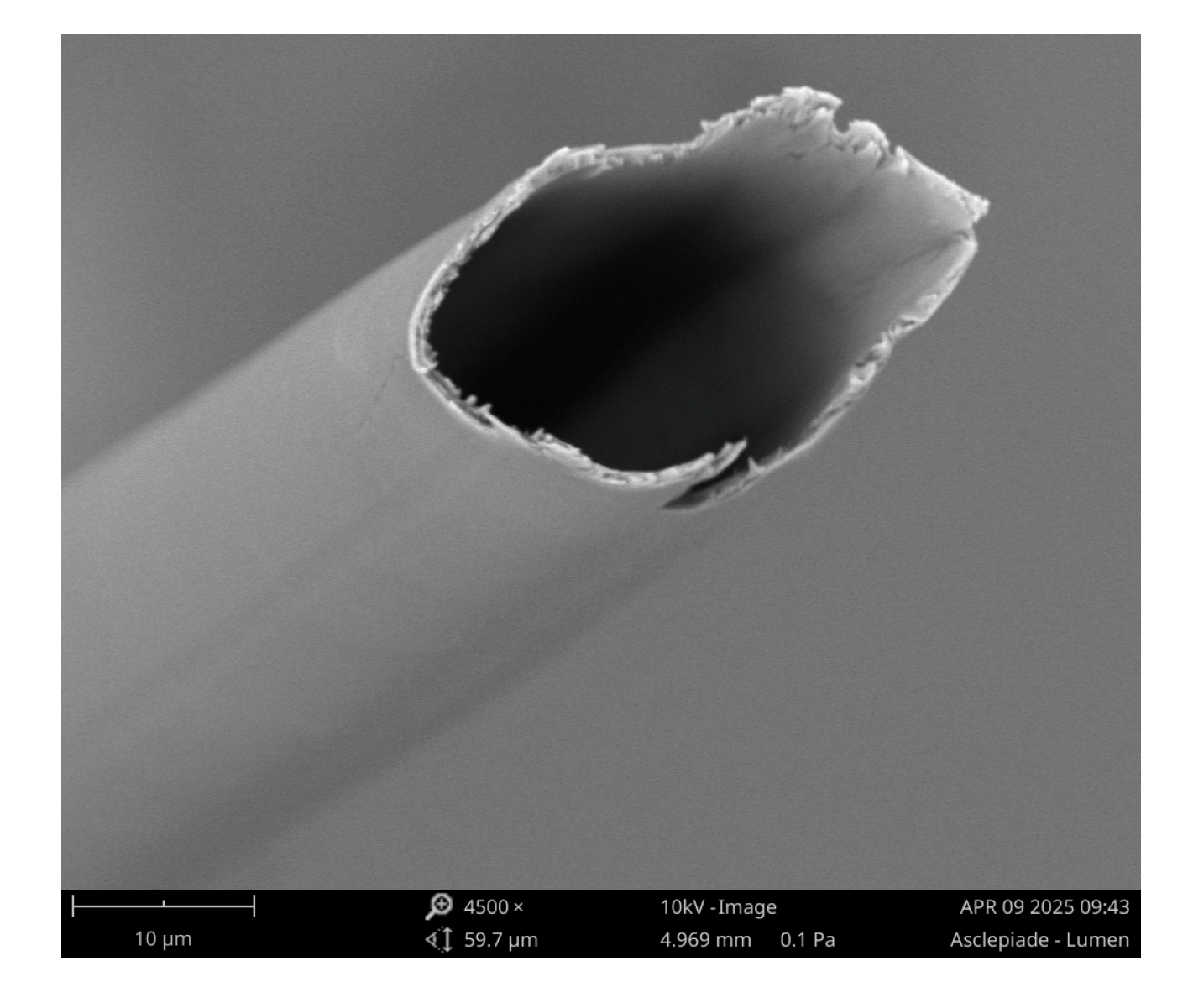
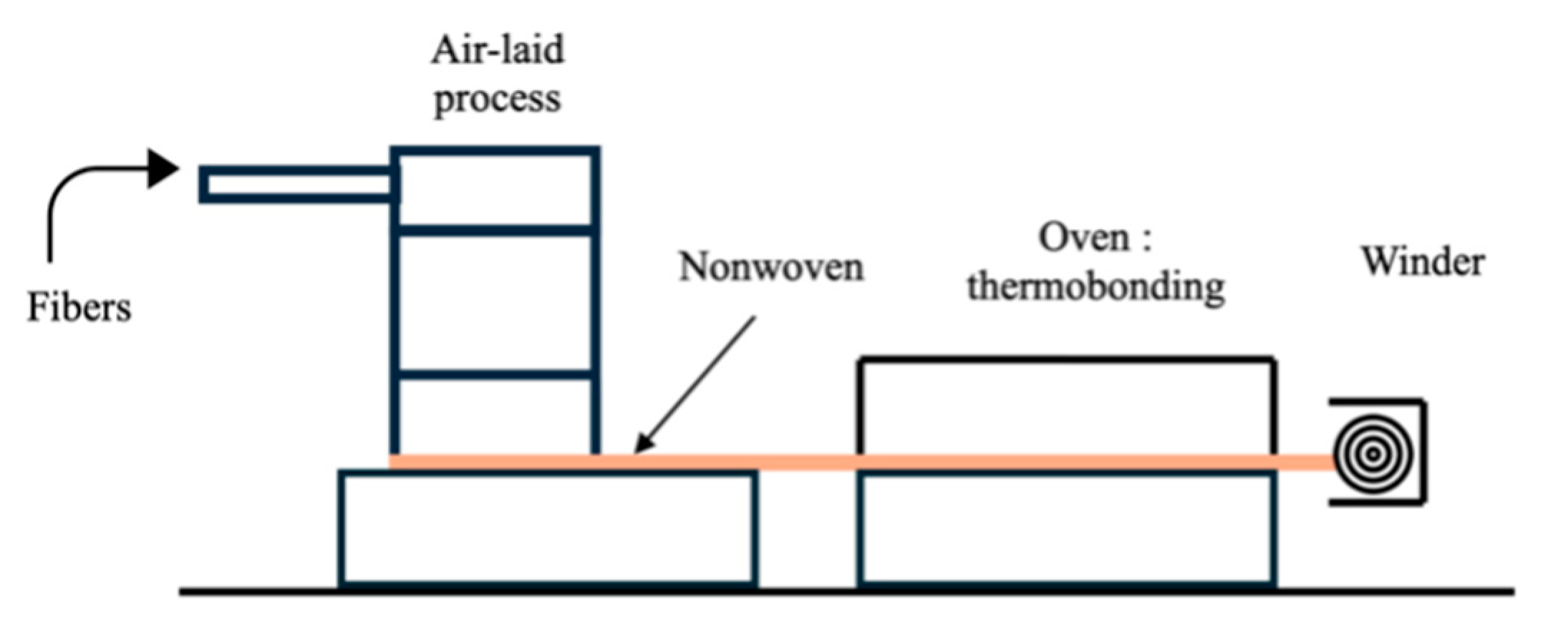


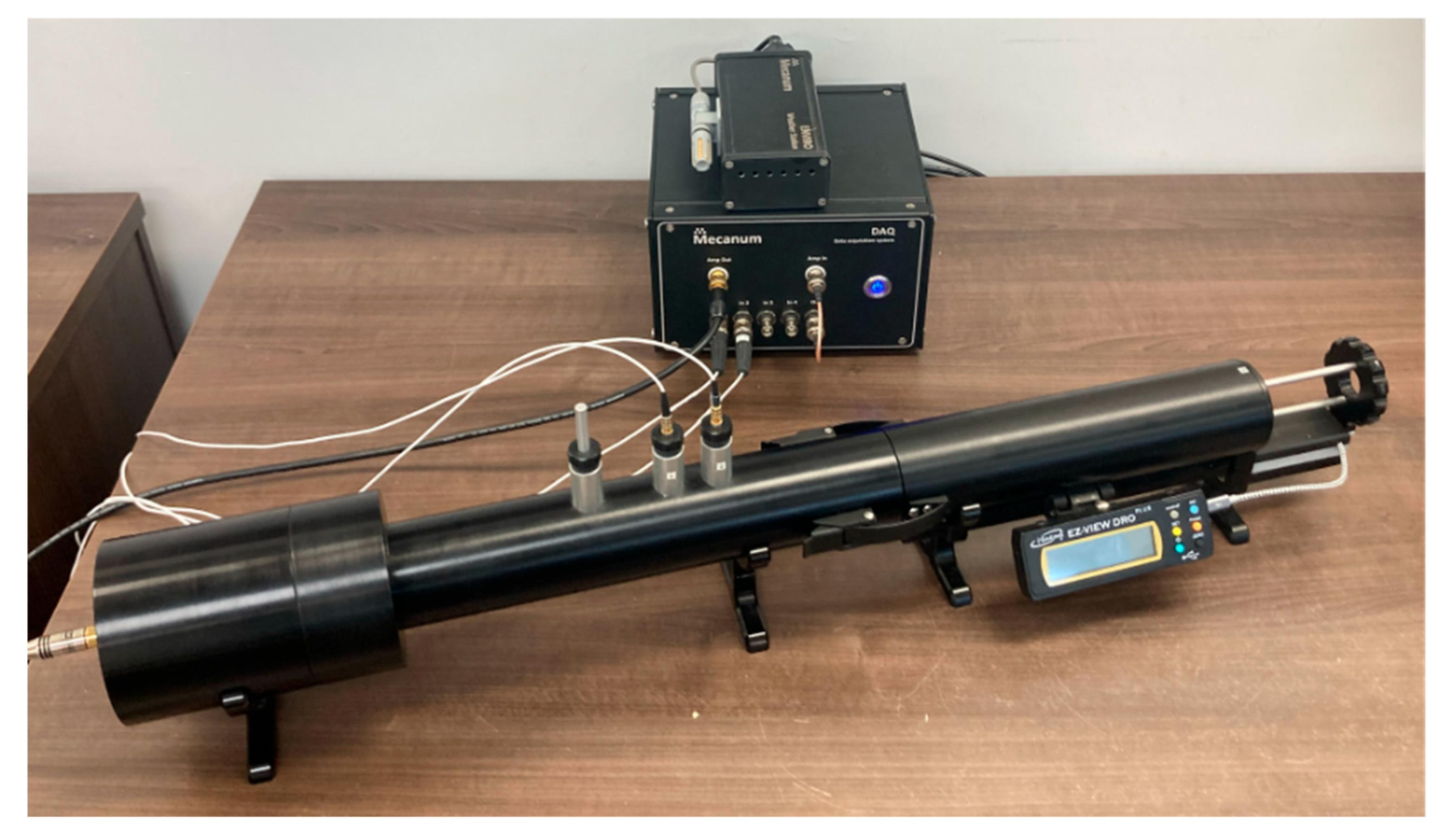

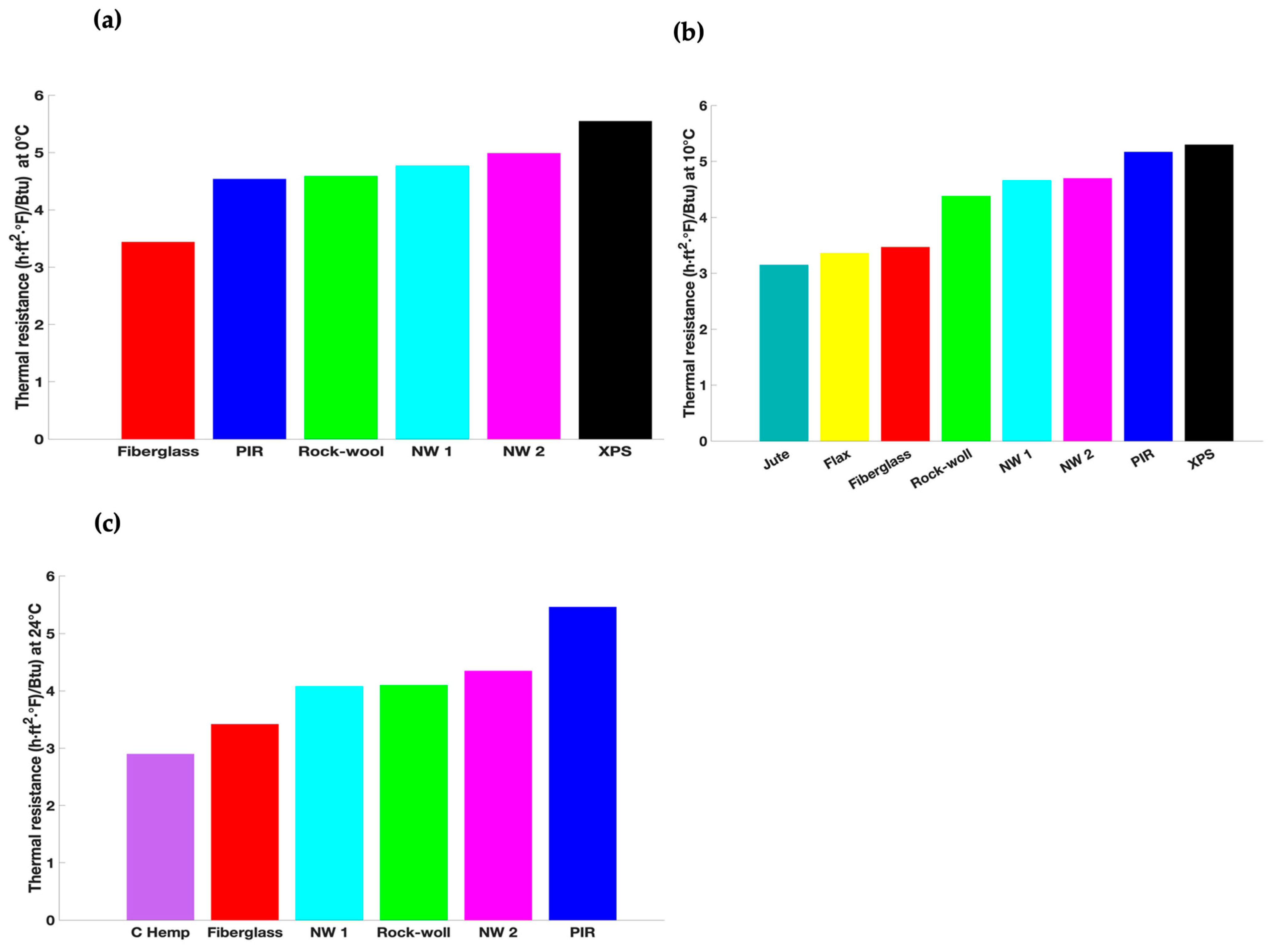
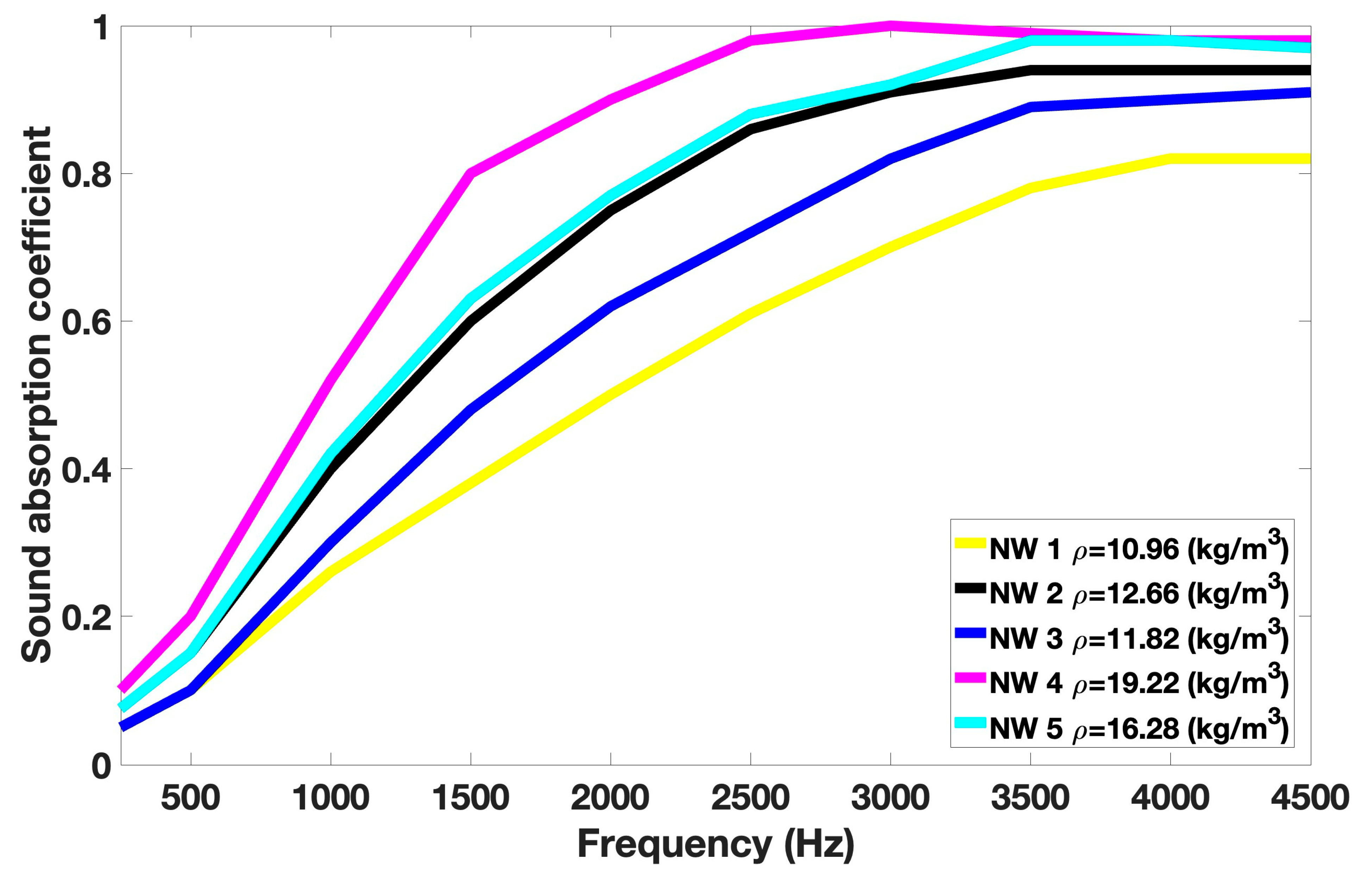
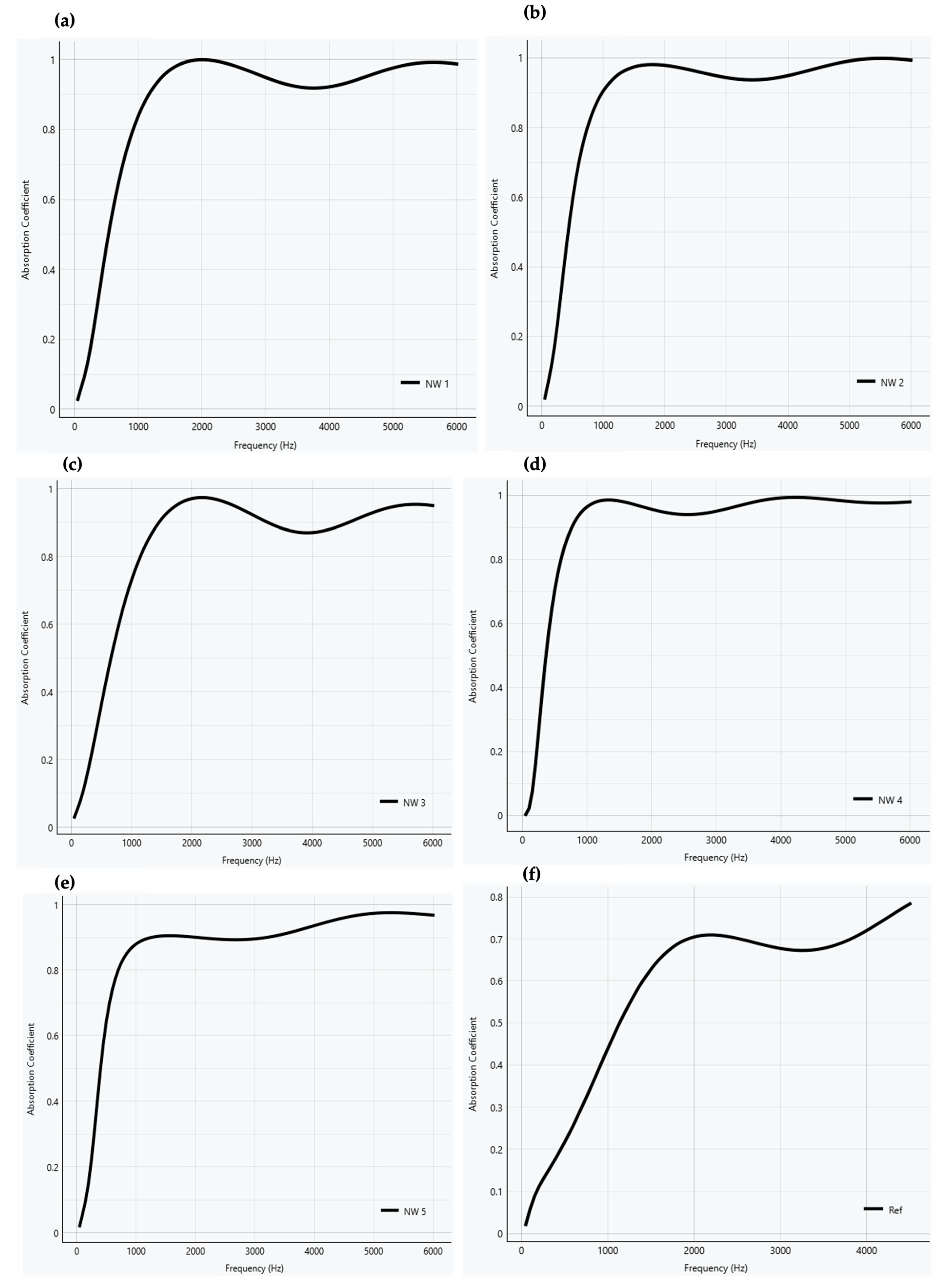
| Samples | MW (wt%) | LM 2.2 (wt%) | PLA (wt%) |
|---|---|---|---|
| 1 | 30 | 10 | 60 |
| 2 | 70 | 10 | 20 |
| 3 | 50 | 20 | 30 |
| 4 | 50 | 10 | 40 |
| 5 | 50 | 40 | 10 |
| Sample | MW (wt%) | Thickness (mm) | Standard Deviation (mm) | Density (kg/m3) |
|---|---|---|---|---|
| NW 1 | 30 | 25.54 | 0.16 | 10.96 |
| NW 2 | 70 | 25.53 | 0.35 | 12.66 |
| NW 3 | 50 | 25.50 | 0.24 | 11.82 |
| NW 4 | 50 | 25.52 | 0.46 | 19.22 |
| NW 5 | 50 | 25.51 | 0.60 | 16.28 |
| Ref | 0 | 50.02 | 0.39 | 33.24 |
| Sample | λ (mW/m·K) T = −4 °C | λ (mW/m·K) T = 0 °C | λ (mW/m·K) T = 5.5 °C | λ (mW/m·K) T = 10 °C | λ (mW/m·K) T = 24 °C | Relationship |
|---|---|---|---|---|---|---|
| NW 1 | 29.69 (0.01) | 30.26 (0.05) | 30.95 (0.05) | 31.32 (0.01) | 35.32 (0.04) | λ = 0.1995T + 30.091 |
| NW 2 | 28.37 (0.05) | 28.92 (0.01) | 29.02 (0.01) | 30.34 (0.04) | 33.13 (0.03) | λ = 0.1727T + 28.729 |
| NW 3 | 29.55 (0.06) | 29.97 (0.02) | 30.48 (0.02) | 31.32 (0.03) | 33.96 (0.09) | λ = 0.1593T + 29.905 |
| NW 4 | 28.97 (0.02) | 29.38 (0.01) | 29.8 (0.01) | 30.18 (0.02) | 32.81 (0.02) | λ = 0.1365T + 29.259 |
| NW 5 | 29.58 (0.03) | 30.11(0.01) | 30.65 (0.02) | 31.1 (0.05) | 33.65 (0.02) | λ = 0.1440T + 29.995 |
| Ref | 42.44 (0.12) | 43.4 (0.12) | 44.05 (0.14) | 44.67 (0.15) | 49.43 (0.14) | λ = 0.2450T + 43.058 |
| Material | Density (kg/m3) | λ (mW/m·K) | Reference |
|---|---|---|---|
| Milkweed nonwoven | 10.96–19.22 | 28.37–35.32 | [21] |
| Blanket Fiberglass | 12–56 | 33–40 | [45] |
| Blanket Polyethylene | 35–40 | 41 | [45] |
| Rockwool Loose-fill Blown-in Poured-in | 24–36 | 46–54 | [45] |
| Kenaf | 30–180 | 34–43 | [52] |
| Sheep wool | 10–25 | 38–54 | [52] |
| Sample | R )/Btu T = −4 °C | R )/Btu T = 0 °C | R )/Btu T = 5.5 °C | R )/Btu T = 10 °C | R )/Btu T = 24 °C |
|---|---|---|---|---|---|
| NW 1 | 4.86 | 4.77 | 4.66 | 4.60 | 4.08 |
| NW 2 | 5.08 | 4.99 | 4.87 | 4.75 | 4.35 |
| NW 3 | 4.88 | 4.81 | 4.73 | 4.60 | 4.25 |
| NW 4 | 4.98 | 4.91 | 4.84 | 4.78 | 4.4 |
| NW 5 | 4.88 | 4.79 | 4.7 | 4.64 | 4.29 |
| Ref | 3.40 | 3.32 | 3.27 | 3.23 | 2.92 |
| Samples | Airflow Resistivity (Pa·s/m2) | Porosity | Tortuosity | Viscous Characteristic Length | Thermal Characteristic Length |
|---|---|---|---|---|---|
| NW 1 | 9986 | 0.982 | 1.01 | 296.5 | 592.9 |
| NW 2 | 14,177 | 0.985 | 1.03 | 220.2 | 440.4 |
| NW 3 | 12,493 | 0.982 | 1.02 | 347.1 | 694.2 |
| NW 4 | 21,150 | 0.997 | 1.05 | 55.6 | 111.2 |
| NW 5 | 20,370 | 0.997 | 1.05 | 350.2 | 700.5 |
| Sample | Thickness 25 mm | Rating Class Thickness 25 mm | Thickness 50 mm | Rating Class Thickness 50 mm |
|---|---|---|---|---|
| NW 1 | 0.6 | C | 0.8 | B |
| NW 2 | 0.7 | C | 0.85 | B |
| NW 3 | 0.6 | C | 0.85 | B |
| NW 4 | 0.7 | C | 0.9 | A |
| NW 5 | 0.7 | C | 0.9 | A |
| Ref | 0.7 | C |
Disclaimer/Publisher’s Note: The statements, opinions and data contained in all publications are solely those of the individual author(s) and contributor(s) and not of MDPI and/or the editor(s). MDPI and/or the editor(s) disclaim responsibility for any injury to people or property resulting from any ideas, methods, instructions or products referred to in the content. |
© 2025 by the authors. Licensee MDPI, Basel, Switzerland. This article is an open access article distributed under the terms and conditions of the Creative Commons Attribution (CC BY) license (https://creativecommons.org/licenses/by/4.0/).
Share and Cite
Lupescu, D.; Robert, M.; Elkoun, S. Milkweed Fiber Nonwovens for Sustainable Thermal and Acoustic Building Insulation. Materials 2025, 18, 3821. https://doi.org/10.3390/ma18163821
Lupescu D, Robert M, Elkoun S. Milkweed Fiber Nonwovens for Sustainable Thermal and Acoustic Building Insulation. Materials. 2025; 18(16):3821. https://doi.org/10.3390/ma18163821
Chicago/Turabian StyleLupescu, Deborah, Mathieu Robert, and Said Elkoun. 2025. "Milkweed Fiber Nonwovens for Sustainable Thermal and Acoustic Building Insulation" Materials 18, no. 16: 3821. https://doi.org/10.3390/ma18163821
APA StyleLupescu, D., Robert, M., & Elkoun, S. (2025). Milkweed Fiber Nonwovens for Sustainable Thermal and Acoustic Building Insulation. Materials, 18(16), 3821. https://doi.org/10.3390/ma18163821








